This incredible Beef in Black Bean Sauce recipe is from Hannah, a chef at RecipeTin Meals, and it’s the best I’ve ever had! Born and raised in China, Hannah comes from a multigenerational family of chefs. So unsurprisingly, she has extremely high standards when it comes to Chinese food!!
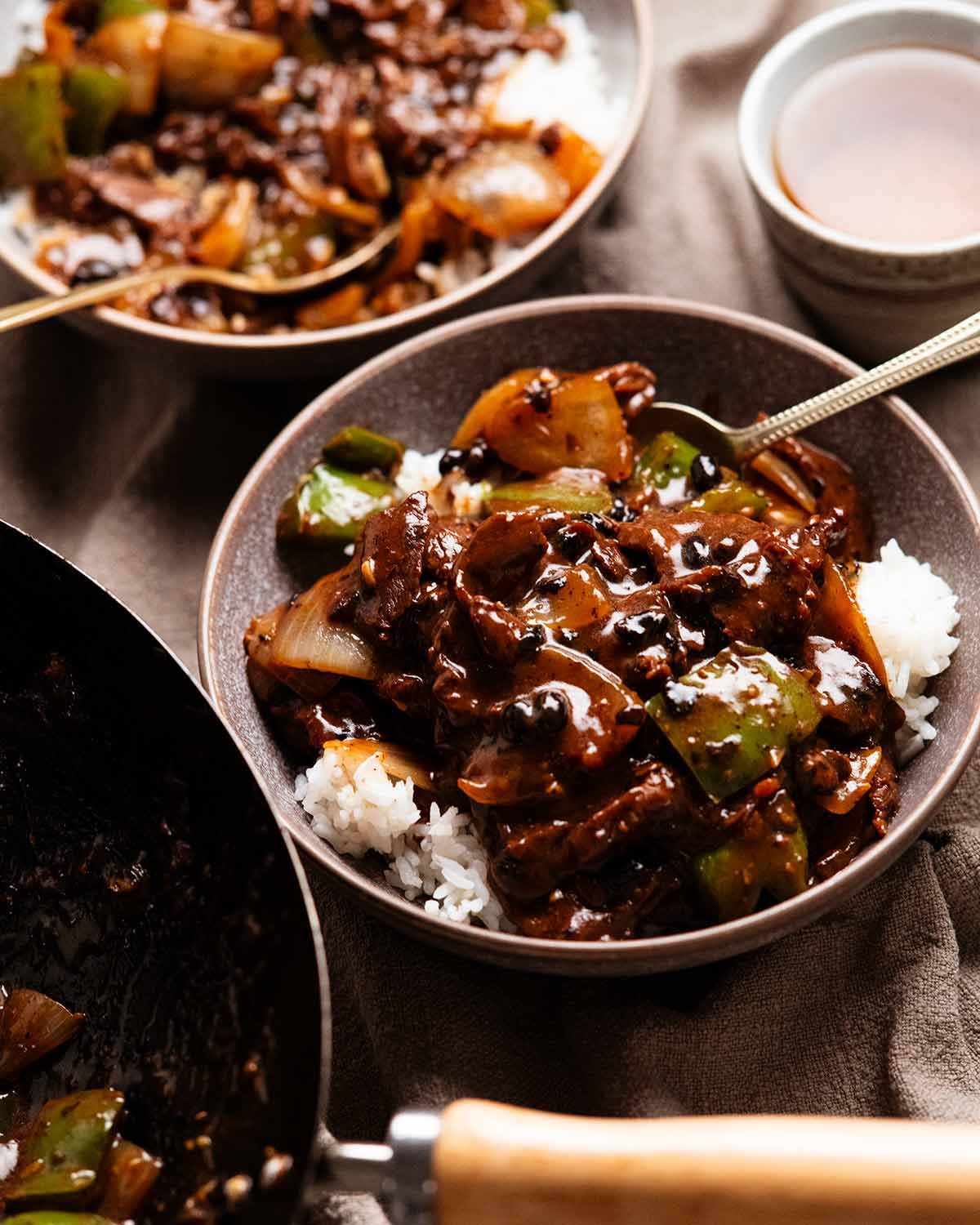
Beef in black bean sauce is finally here!
Beef in black bean sauce has been one of the most requested reader recipes for years, but I haven’t been brave enough to share it because I never felt my sauce was quite right. This is a beloved Chinese restaurant classic that needs to be done properly!
As it turns out though, we have a brilliant Chinese chef at our food bank – Chef Hannah – and we’ve been using her Beef in black bean sauce recipe at RecipeTin Meals for almost a year, making meals for the vulnerable. Her recipe is a dead ringer for gold standard Chinese restaurants – but better, because you can taste the ingredients more.
This is Chef Hannah, making the Beef in Black Bean at RTM. Just 600 servings!

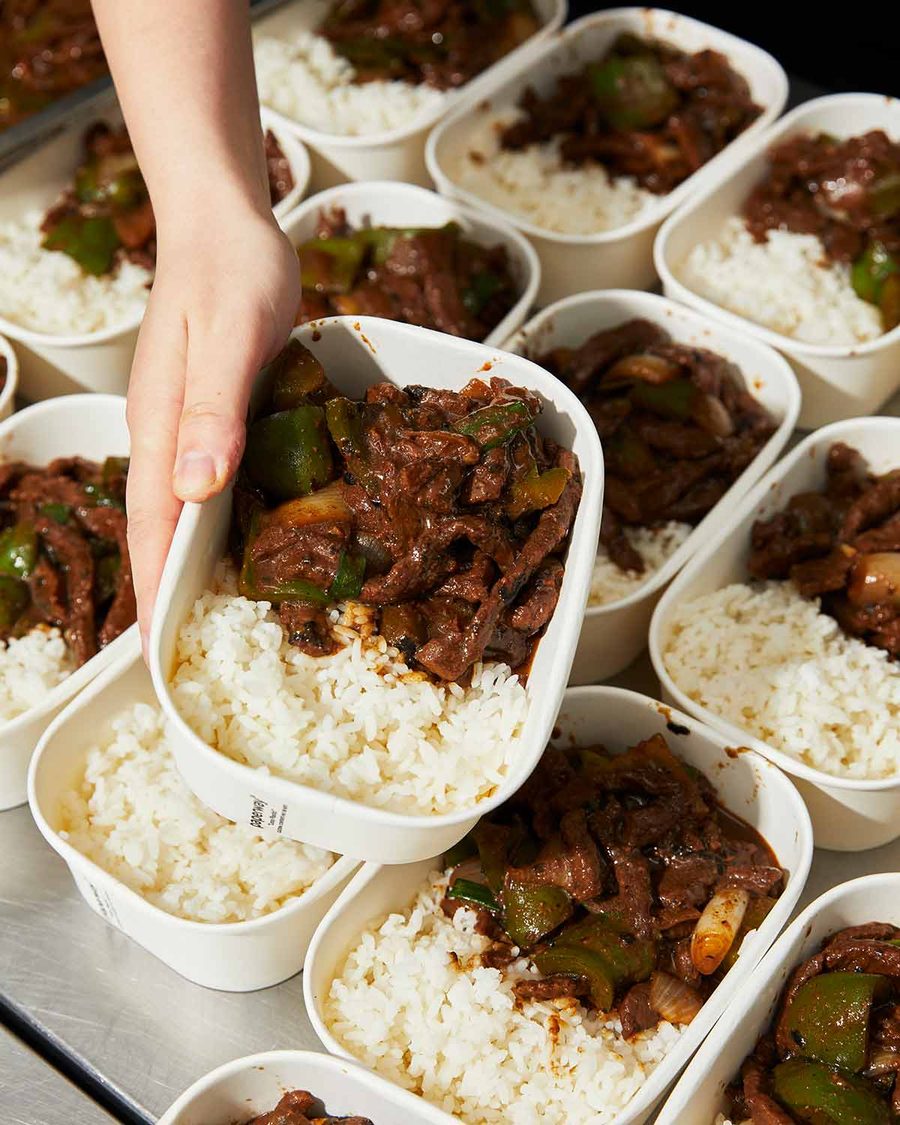

70% cheaper – and counting
The other big thing this homemade version has going for it is that you’ll also save a bomb – almost 70% of the cost. Higher end Chinese restaurants charge over $30 for a serving about one-third of the size of what this recipe makes. The ingredients to make this at home will cost you less than $25. Closer to $15 if you use the economical beef option which, hand on heart, is 95% as good. I was blown away by how good it was! More on this in the ingredients section below.
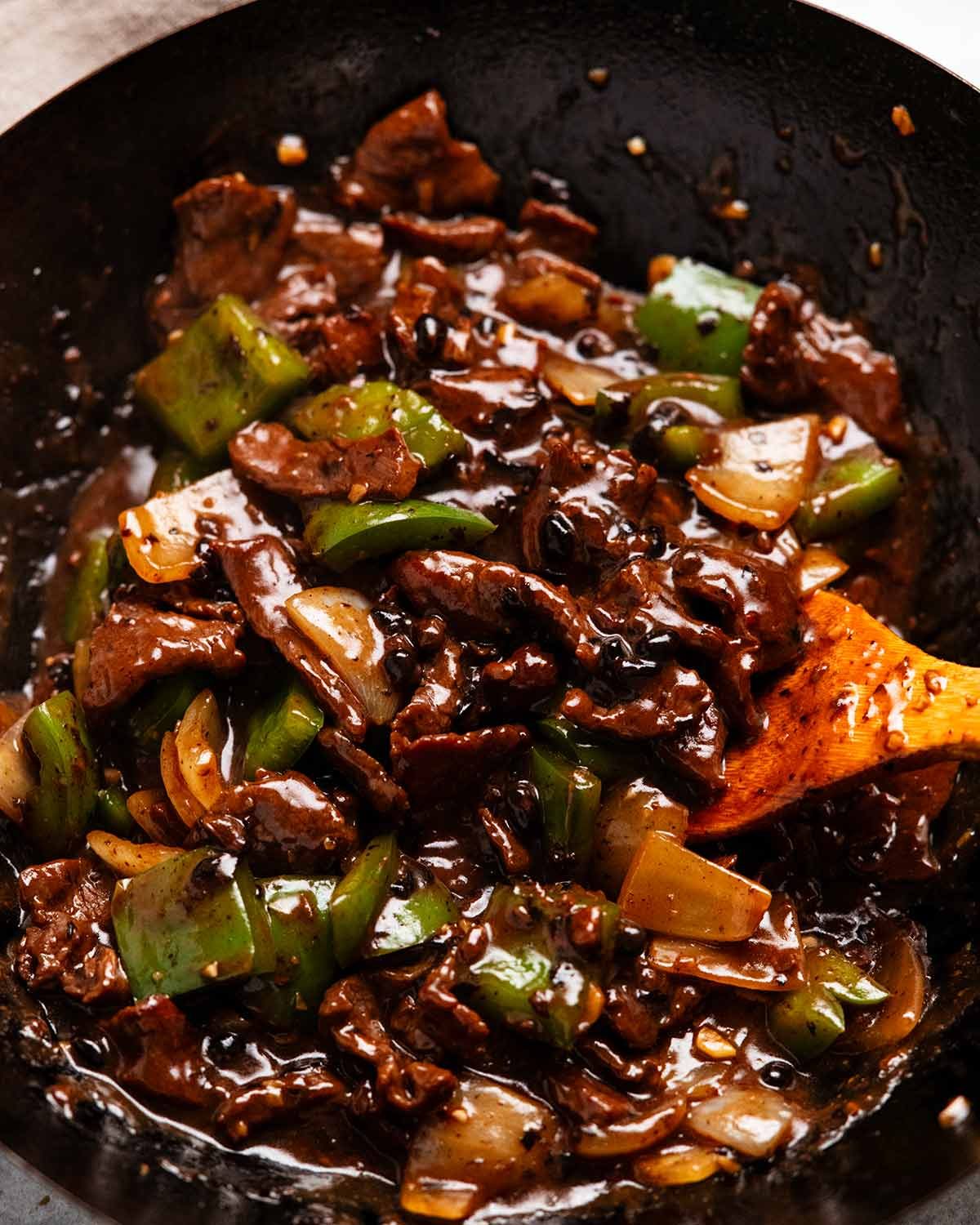
Ingredients in beef in black bean sauce
We are making the black bean sauce from scratch today because it tastes way better than the jarred stuff which, to be honest, barely resembles the real deal. So the key ingredient in today’s recipe is the black beans, and yes you will need to go to an Asian store. But they’re cheap ($2.50 for small packs), common and will last *forever* (though I’ll wager you use them all up making this recipe over and over – try it with chicken next!).
Once you get the black beans though, you’ll be happy to know that all the other ingredients are basic Asian sauce essentials. 🙂
1. PRESERVED black beans for Chinese black beans sauce
This is what preserved black beans looks like – shrivelled up raisins:
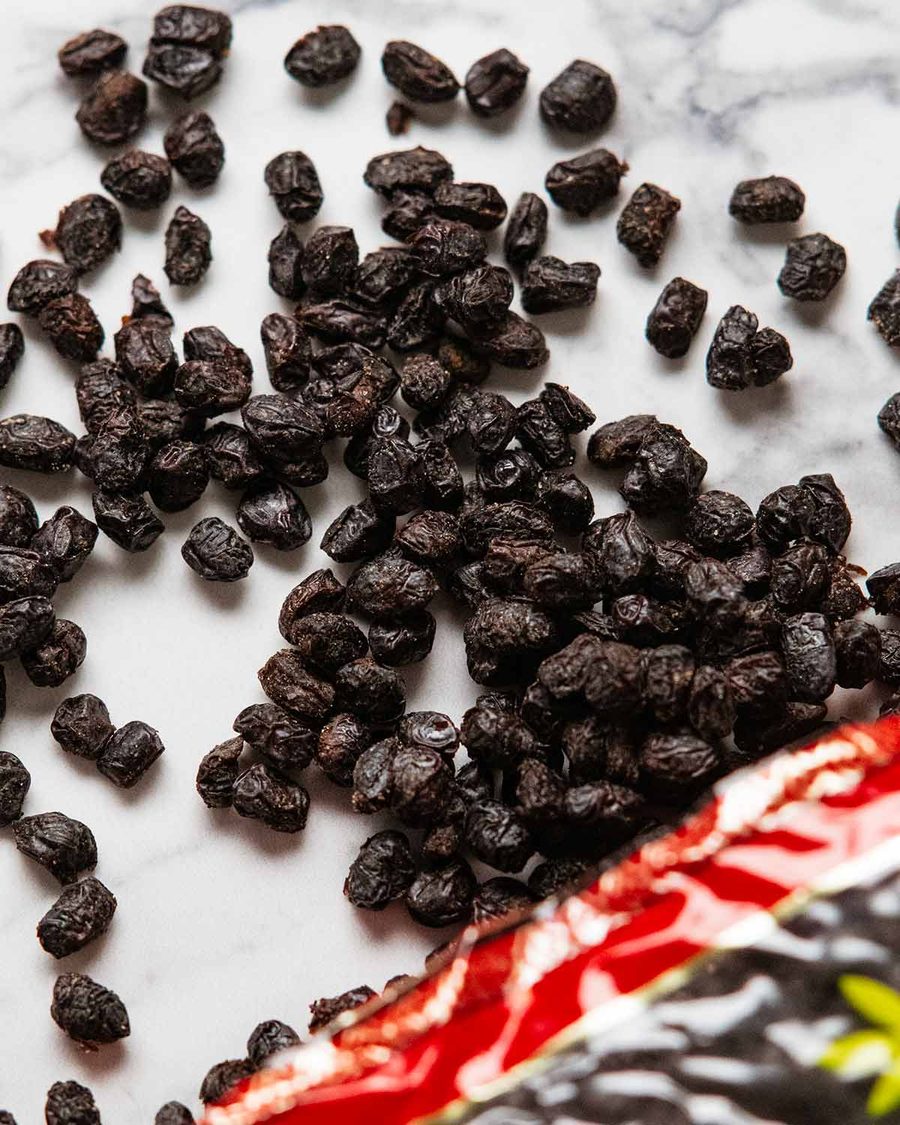
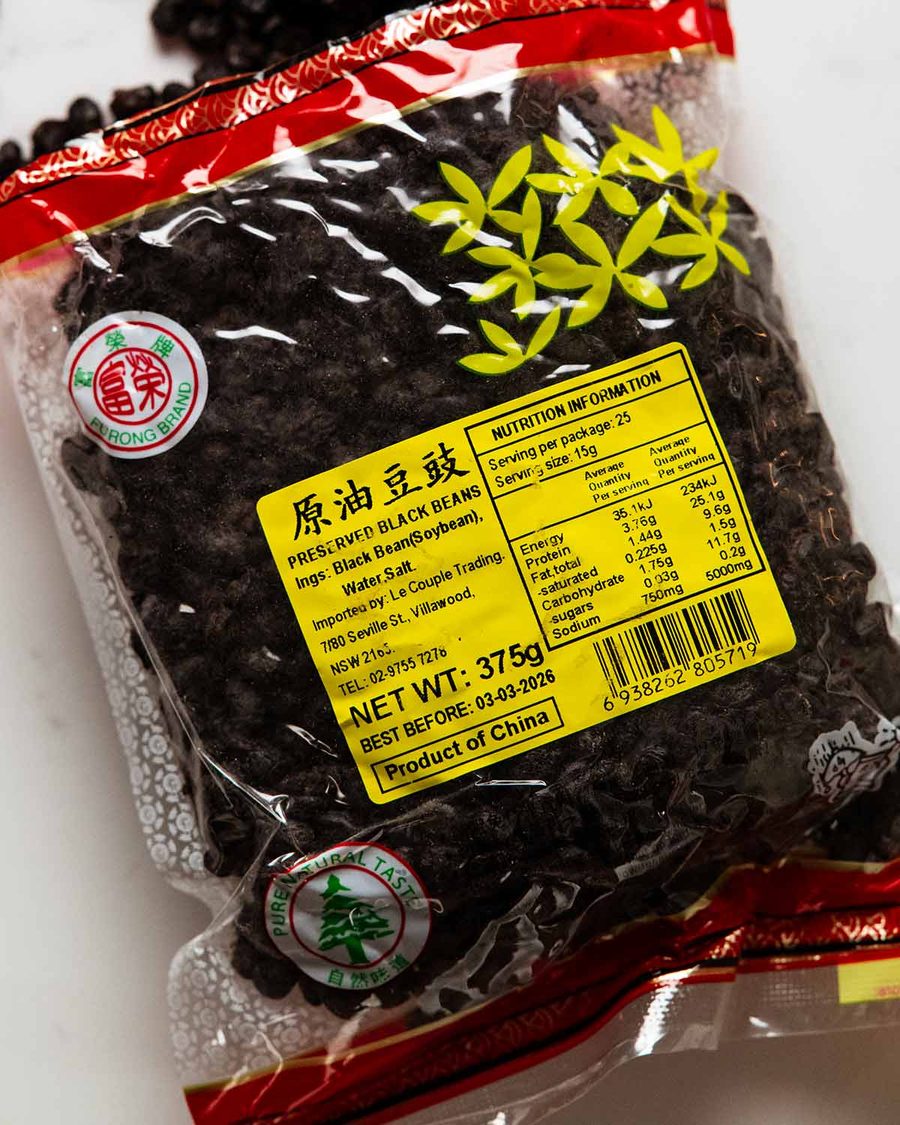
What Chinese salted black beans are – black soy beans that have been fermented in salt which add savouriness and salt into the dish. They are a little squishy – like extra firm raisins.
Other names – Preserved black beans are also called:
Salted or fermented black beans
Any combination of the above: eg salted preserved black beans
Black beans (in an Asian grocer, not a Western grocer – see note above!)
Douchi (dòu chǐ in Mandarin or dau6si6 in Cantonese, 豆豉 – thank you for the language lesson Woks of Life!)
Find them at Asian grocery stores alongside pickled and vac packed vegetables. They cost around $2.70 for the smallest packs.
No suitable substitute that I can think of.
Not to be confused with Western dried black beans which are rock hard. Canned black beans (ie regular Western ones) cannot be used, they are not the same thing (see above – salted black beans are actually soy beans!).
2. BEEF AND MARINADE
Here’s what you need for the beef and marinade.
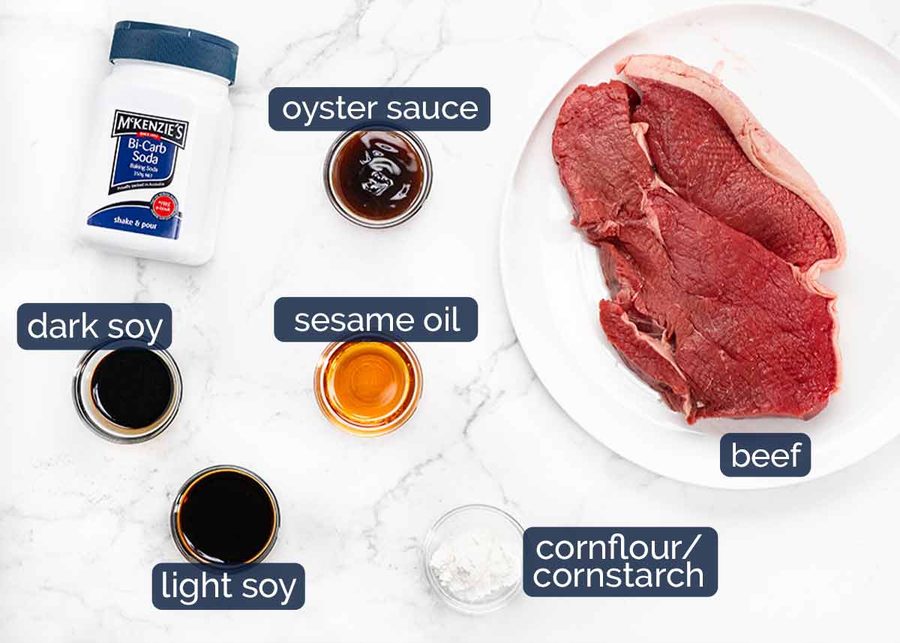
Beef (rump steak) – The base recipe calls for rump steak (US: top sirloin) – for flavour, value and texture. Scotch/rib eye and porterhouse/sirloin (strip) are also great but more expensive.
Economical cuts (65% cheaper) – blade roast (brilliant!) and chuck work extremely well, however, the recipe needs to be alternated for a longer marinade time (24 hours instead of 1 hour). See expandable accordion below for more information.
Beef options
Rump steak – called top sirloin in the US. Reason: good beefy flavour, good chew but not tough, not too tender (fillet is too tender, in my opinion), doesn’t take long to tenderise in the marinade (1 hour), is one of the more economical steaks.
These work just as well as rump but they didn’t make it better. As they are more expensive, we opted not to use them for the base recipe.
We’ve tested this recipe using economical beef cuts – and the results were incredible! I was so excited to find how well it works with cheaper beef cuts. But there’s a catch – you need to either marinade for longer (24 hours instead of 1 hour) OR use a more aggressive tenderising technique (outlined below) which is faster but a two-step process (1 hour 40 minutes). See next drop down for details, or recipe card.
Here are the top recommended economical beef cut options:
Blade Roast ($13/kg here in Australia, 65% cheaper than rump), also called bolar blade or chuck blade. Excellent flavour, excellent texture once tenderised, easy to cut, easily found at regular grocery stores. Full marks!
Chuck beef – came in a close second. Similar texture once tenderised but the beef flavour is not quite as strong and it is a little more fiddly to slice (fat and tendons get in the way).
Brisket – Haven’t tried specifically for this recipe but given the above 2 work so well and having extensively tested various beef cuts for baking soda tenderising times in my second cookbook, Tonight, I am confident it will work.
Gravy beef will work but because of the way the meat fibres run, it can be fiddly to cut stir-fry-size meat strips.
Other economical cuts – topside (called round steak or roast in the US and UK – bottom, top, eye)
Blade roast is a slow cooking cut of meat which comes from the same area of the cow as chuck beef that is commonly used for stews and similar slow cooked recipes. In Australia it is usually sold in roast / block form ~1.5kg+/3lb. So you’ll have to buy more than you need for a single batch of this recipe, but it freezes perfectly for all your future beef stir fry needs! It’s also a cut that is easy to slice into lots of thin pieces for stir fries because it’s not ribboned with sinew and fat that can be fiddly to cut around. Find it at regular grocery stores!
Chuck beef is not as uniform in shape as blade and requires a bit more fiddling to cut around sinew and fat to get the beef slices. Also, the beef flavour is not quite as strong. Because of these reasons, it came in second!
Use either of these two methods if you’d like to use the economical beef cuts for this recipe:
Extended marinade – Follow the recipe as written, but leave the beef to marinade for 24 hours rather than 1 hour.
Two-step fast tenderise – Toss the plain beef slices with 1 1/4 teaspoons baking soda and set aside for 40 minutes to tenderise (this is basic beef velveting – more information here). Rinse in a colander, shake and pat off excess water. Then marinade per recipe but leave out the baking soda and proceed with the recipe as written.
Because this recipe calls for a fair amount of beef (400g/14oz) compared to regular beef stir fries (typically 200g/7oz or less). Also, this is an iconic dish and I want everyone to be able to enjoy this without worrying about cost.
JB made 6 versions of this recipe side by side using various cuts of beef and different tenderising methods, using the knowledge and previous testing I’ve done on velveting beef, both for this website (velveting beef post here) and my cookbook Tonight which has a double page cheat sheet on how to tenderise meat for stir fries.
We knew it could be done for Beef in Black Bean Sauce and expected it to be pretty good – say, 85% as good which, if you can save more than 50% on the cost of beef, is still quite good, in my view.
We did not expect it to be as good as it is! Hand on heart, I honestly say that blade is 95% as good as rump steak. We were so amazed, and so excited to be able to share this tip in today’s recipe!
Tender, very lean, most expensive cut of beef, we feel it’s wasted in stir fries. Hannah actually made this recipe using tenderloin but said she didn’t like it – the beef doesn’t colour nicely, it also gets a little too weirdly tender when tenderised (which you still have to do because in stir fries, any thin strip of beef overcooks) and it also doesn’t have a very strong beef flavour so it gets completely overwhelmed by the sauce.
skirt
flank
similar cuts popular in South American grilling
pre cut stir fry strips
cheek
short rib / beef rib
shank
minute steak / sizzle steak (ie the very thin steaks)
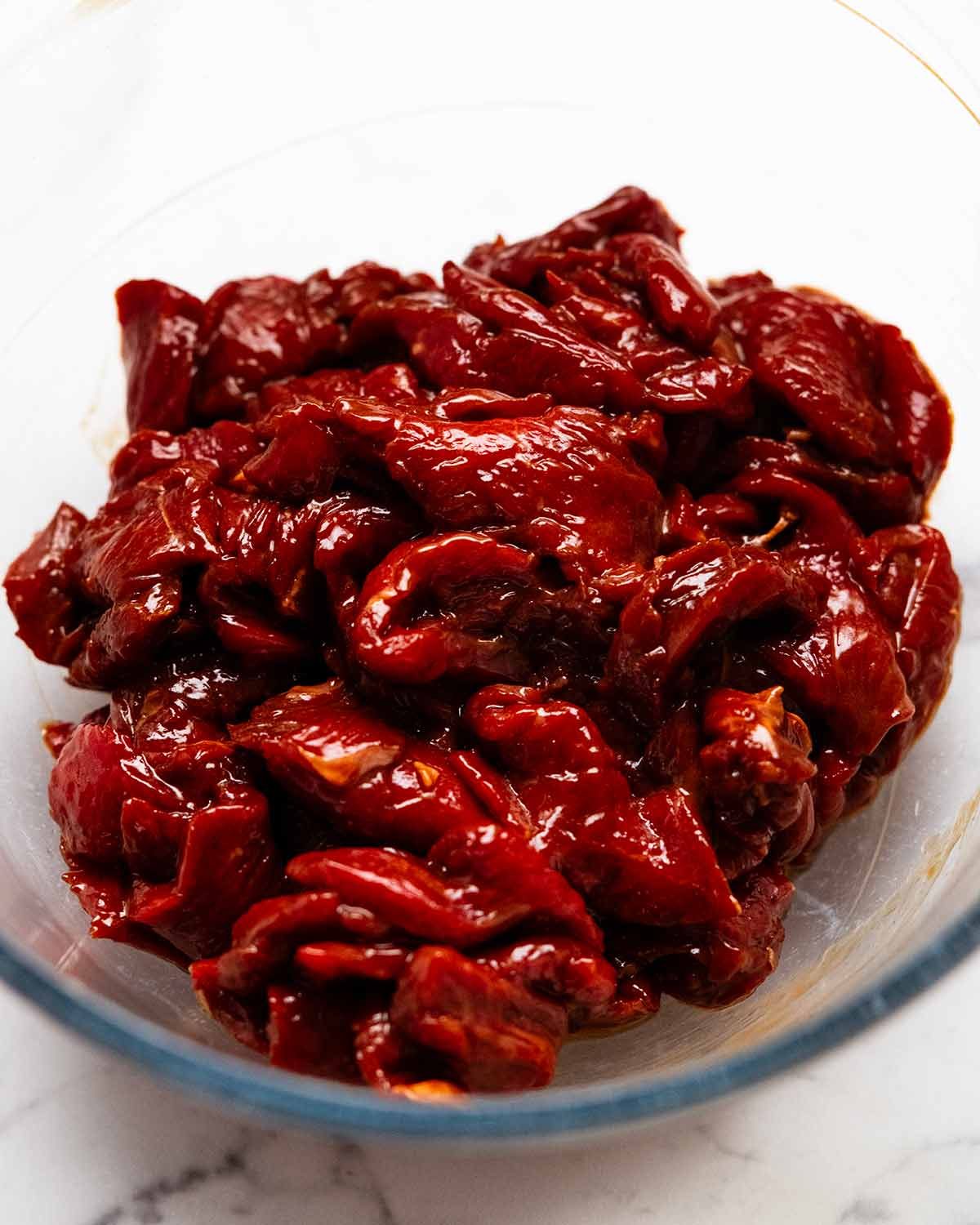
Marinade
Baking soda (bicarbonate) – A small amount (just 1/4 teaspoons) mixed into the marinade tenderises the beef beautifully so it stays soft. Without, the beef will overcook and become tough. I tried and proven tenderising method used liberally in my Asian recipes!
Light soy sauce – You can substitute with an all purpose soy sauce. But not dark soy sauce – flavour is too strong and the colour is too intense! More on which soy sauce to use when here.
Dark soy sauce – Stains the beef and adds more intense soy flavour than light soy. You can substitute with more light soy sauce but the beef colour will not be the same and the flavour will be a little lighter.
Oyster sauce – A staple Asian sauce that adds complexity, flavour and umami all at once. Made from oyster extract that is sweet, salty, thick and pungent, but doesn’t taste oyster-y or fishy at all once cooked. Can be substituted with shellfish free alternative – vegetarian “oyster” sauce, even found at regular grocery stores these days.
Cornflour / cornstarch – This makes the beef cook so it has a thin film-like coating on it which makes it sort of slippery, just like you get at Chinese restaurants.
3. THE STIR FRY AND SAUCE
Here’s what you need for the sauce and the vegetables in the stir fry. The sauce is very simple and only uses 1 tablespoon of soy sauce because this dish gets most of its flavour from the black beans.
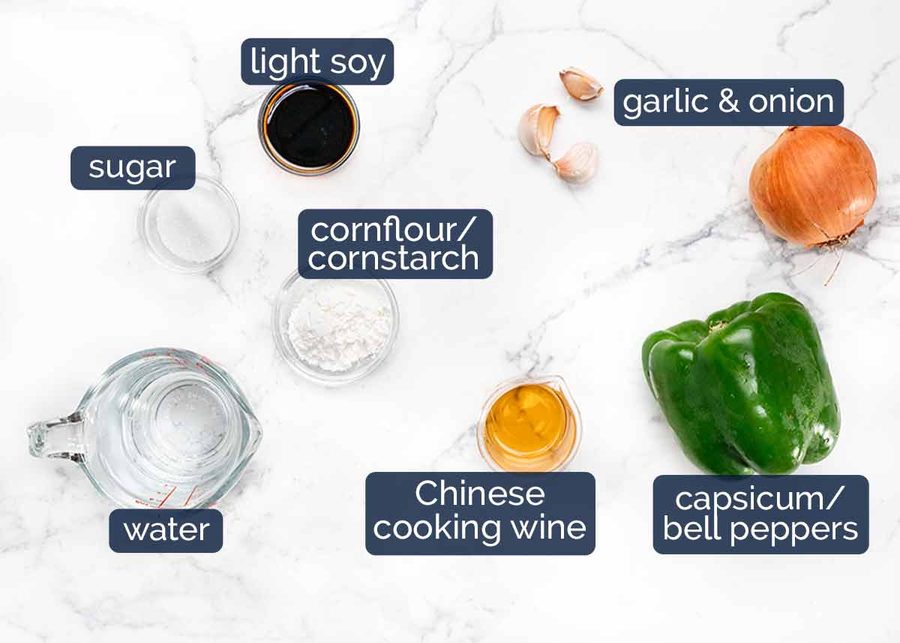
Chinese cooking wine (“Shaoxing wine”)- essential ingredient for making truly “restaurant standard” Chinese dishes. Substitute with cooking sake or dry sherry. Non alcoholic substitute – substitute half the water with low sodium chicken stock/broth.
Light soy – see notes in the above section. Don’t use dark soy sauce, it’s too intense!
Cornflour / cornstarch – thickens the sauce and makes it shiny.
Sugar – to get the right sweetness in the sauce
Water – quite a lot, a whole cup! There’s a lot of stir fry. We need plenty of sauce!
Green capsicum / bell pepper – the traditional colour for beef in black bean here in Australia. Feel free to go wild and use red or yellow if you want. 😳 (I’m not rebellious enough).
Onion and garlic – Try to find a stir fry recipe on my website that doesn’t have these. (You won’t!). The onion is cut into squares which is the traditional shape used for this dish in Chinese restaurants.
Oil – for cooking. Peanut oil, canola, vegetable oil – anything with a neutral flavour.
How to make Beef in black bean sauce
The beef needs 1 hour to marinade to infuse with flavour and tenderise. Use this time to soak the black beans and prepare the other ingredients. The cooking part itself takes barely 10 minutes!
1. Marinade

Slice – Finely slice the beef into 3mm / 0.1″ thick pieces.
Pro tip (optional): If you just slice steak, the beef pieces are quite skinny. For nice large pieces aka restaurant style, cut 2.5 x 4cm pieces (1 x 1.5″) pieces out of the steak, stand on its side then slice finely so you get larger 2.5 x 4cm pieces (1 x 1.5″) slices.
Marinade – Mix all the marinade ingredients except the sesame oil. Then toss to coat the beef, then add the sesame oil and toss. Adding the sesame oil later helps to “seal” the marinade ingredients into the beef.
Marinade for 1 hour in the fridge. (Remember: if using economical beef, marinade 24 hours).
2. SOAKING the preserved black BEANS

Soak black beans in water for 30 minutes to 1 hour. They will plump up and soften so they’re pleasant to bite into and release more flavour into the sauce.
Drain – Then drain in a colander and just put it aside until ready to cook.
3. HOW TO COOK BEEF IN BLACK BEAN SAUCE
For real restaurant style, the beef needs to be shallow fried which makes the surface of the beef slippery and softer than sautéing. However, I promise you are still going to love this if you opt to just sauté in a little oil instead!

Shallow fry beef – Heat the oil over high heat in a wok then cook the beef for 1 minute until it changes from red to brown. If opting for the less oil option, just heat 2 tablespoons of oil then stir the beef for 45 seconds like you’re making a regular beef stir fry, until the surface of all the beef is cooked.
Cooking vessel – Wok works best because you get more oil depth though it works well in a pan too. Use a large deep one as this recipe makes a fairly generous amount!
Remove the beef using a slotted spoon onto a plate.

Discard most of the oil but keep 3 tablespoons for cooking.
Aromatics first – Cook the black beans first for 20 seconds, then add the garlic and stir for 10 seconds. Add the onions and capsicum first and stir for 1 minute until the edges of the onion starts to soften.

Beef and Chinese cooking wine – Add the beef and toss for 30 seconds. Then pour the Chinese cooking wine around the rim of the wok so it runs down the side into the beef. This is a classic Chinese cooking technique that “cooks” the wine before mixing with everything else. (It’s not a big deal if you miss though and the wine goes straight into the beef!).
Add the sauce and cook for another minute or until the sauce thickens, becomes shiny and thick enough to coat the beef.
Pour it all into a serving bowl and serve with rice!
Look at this saucy perfection with those little pops of black beans and that beef, that unbelievably tender beef!!
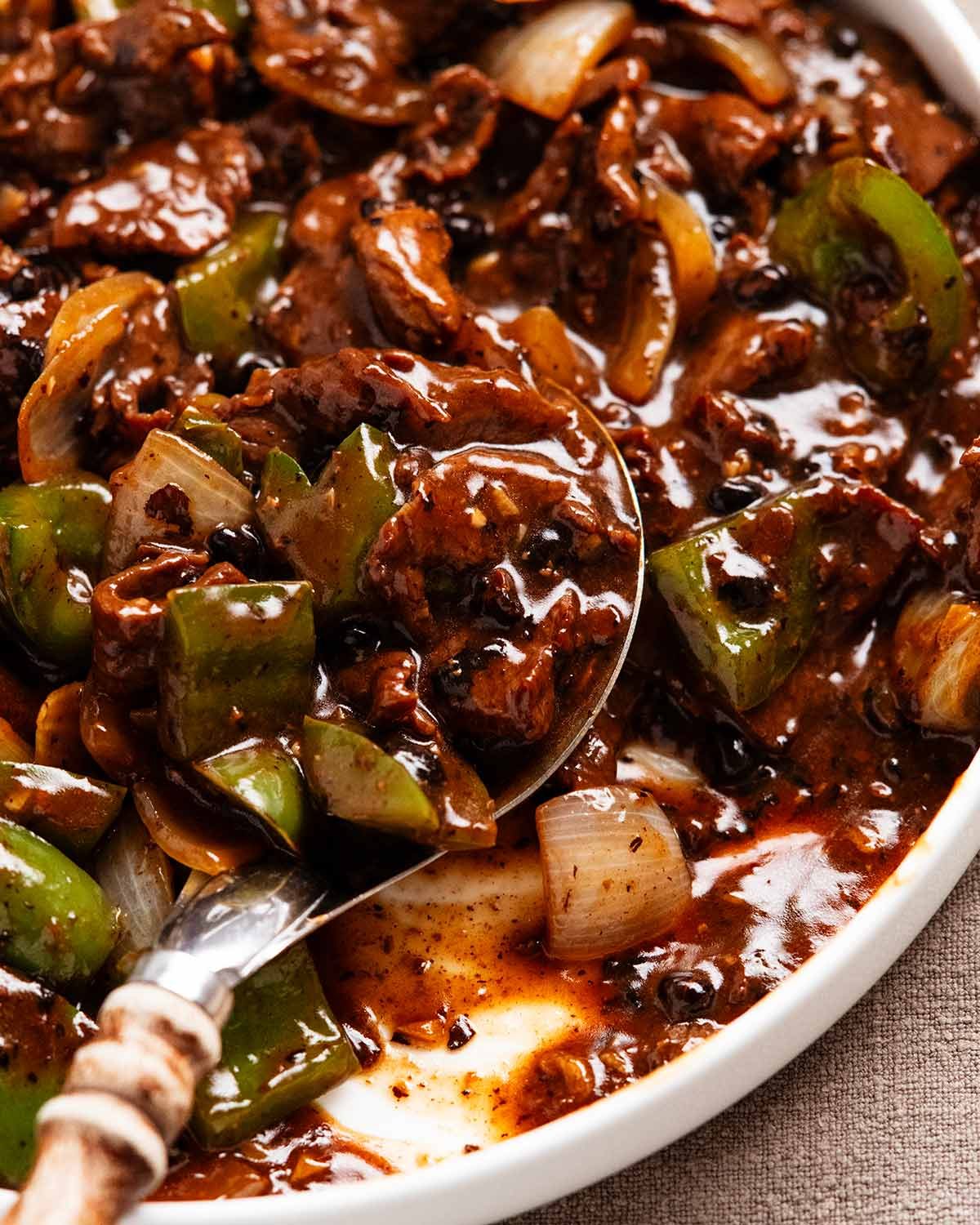
And a nice close up rice soakage shot for you:
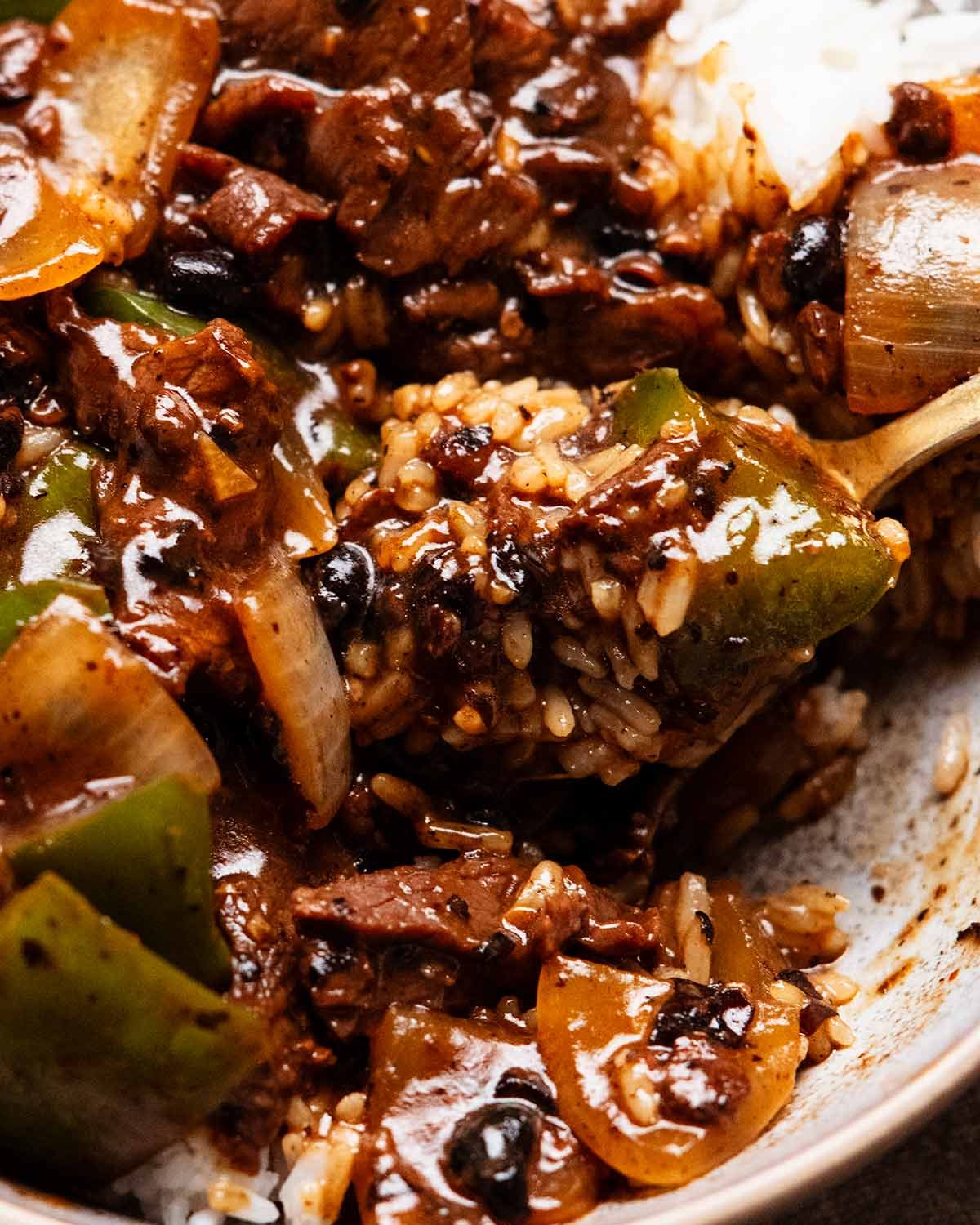
Wow. Just wow.
Thank you Chef Hannah, for this incredible recipe. While we’ve been using this at RTM for a while, the recipe is slightly different because we cook at scale there (600x), we use commercial equipment and the food is designed to be reheated.
So Hannah altered the recipe to make it suitable for home kitchens, and tweaked it to aim for gold-standard Chinese restaurant quality.
She absolutely nailed it. I really hope you give this a go! Hand on heart, I’ve never had better. – Nagi x
Watch how to make it
Hungry for more? Subscribe to my newsletter and follow along on Facebook, Pinterest and Instagram for all of the latest updates.
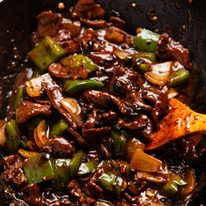
Beef in black bean sauce
Ingredients
- 1/2 cup (75g) preserved black beans (salted black beans, fermented black beans, Note 1)
- 400g/14 oz beef rump steak (US: top sirloin) , thinly sliced 3mm / 0.1" (Note 2)
- 1 brown onion , medium size, cut into 2.5cm/1" squares
- 1 green capsicum (bell pepper), medium size, cut into 2.5cm/1" squares
- 1 tbsp garlic , finely minced with a knife ~ 4 cloves (Note 3)
- 1/2 cup peanut oil (or vegetable, canola) (Note 4)
- 1 tbsp Chinese cooking wine (shaoxing wine) (Note 5)
Tenderising beef marinade:
- 1 tbsp light soy sauce (Note 6)
- 1 tsp dark soy sauce (Note 6)
- 1 tbsp oyster sauce
- 2 tsp cornflour / cornstarch
- 1/4 tsp baking soda (bi-carbonate) (Note 7)
- 1 tbsp sesame oil (toasted ie brown, not untoasted which is yellow)
Sauce:
- 1 tbsp light soy sauce (Note 6)
- 2 tsp white sugar
- 2 tbsp cornflour/cornstarch (20g)
- 1 cup water
Serving:
Instructions
Abbreviated recipe:
- Marinade beef 1 hour, soak beans, mix sauce. Shallow fry beef 30 seconds, remove. Discard all but 3 tbsp oil. Add and cook in this order: black beans 20 seconds, garlic 10 seconds, onion + capsicum 1 minute, beef 1 minute, cooking wine 30 seconds, sauce 1 minute or until thickened. Serve!
Marinade beef:
- Mix the marinade ingredients EXCEPT sesame oil in a bowl. Add beef, mix to coat. Add sesame oil, mix again.
- Marinade – Refrigerate to marinade for 1 hour.
Preparation:
- Soak beans – Put the salted black beans in a medium bowl and cover with water. Set aside for 30 minutes to 1 hour to soak, then drain.
- Mix sauce – Put the cornflour, soy sauce and sugar in a jug or small bowl. Mix until lump free then mix in the water. Set aside.
Cooking:
- Cook beef – Heat the oil in a wok (or non stick pan) over high heat. Add the beef and cook, tossing, for 30 seconds until it changes from red to brown. Remove with a slotted spoon onto a plate.
- Discard most of the oil in the wok, keep just 3 tablespoons.
- Aromatics – Return the wok to high heat. Add the black beans and stir for 20 seconds, then add the garlic and stir for 10 seconds. Add the capsicum and onion, cook for 1 minute.
- Beef – Add beef and any juices pooled on the plate, toss for 1 minute. Pour the Chinese cooking wine around the sides of the wok so it runs down into the beef then toss for 30 seconds (Note 8)
- Sauce – Pour the sauce in, then stir and let it bubble for 1 minute or until the sauce thickens, is shiny and coats the beef beautifully.
- Serve – Pour into a serving bowl and serve with rice!
Recipe Notes:
b) Toss beef with 1¼ tsp baking soda, refrigerate 40 min, rinse well. Then marinate 30 min (without baking soda) and proceed with recipe. Chuck also works, but blade is easier to slice. Other options: brisket, gravy beef, topside/round. Use either a) or b) tenderising methods for these too. More info in Ingredients section. 3. Garlic – Knife best. If using a garlic crusher, add the garlic towards end of onion cooking time (else it will burn). 4. Oil quantity – To truly replicate restaurant silky soft beef, it needs to be shallow fried rather than sautéed. To reduce, use 3 tbsp and sauté the beef instead. 5. Chinese cooking wine (“Shaoxing wine”)– essential ingredient for making truly “restaurant standard” Chinese dishes. Substitute with cooking sake or dry sherry. Non alcoholic sub – substitute half the water with low sodium chicken stock/broth. 6. Soy sauces – Light soy sauce: you can use any all purpose soy sauce but do not use dark soy or sweet soy. Dark soy: can substitute with light or all purpose soy but will lose colour and a bit of soy flavour. More information on soy sauces here. 7. Baking soda is a magic meat tenderiser! More in post or here. 8. Pouring Shaoxing wine around the side of the wok – traditional Chinese cooking technique so it “cooks” the wine before it reaches the ingredients. Leftovers will keep for 3 days in the fridge, keeps very well. Not suitable for freezing (sauce thins). Nutrition per serving, assuming 5 servings, excluding rice. I feel like the sodium is higher than it actually is because salt gets extracted during the soaking step.
Nutrition Information:
Life of Dozer
He genuinely thinks that’s his food bowl:
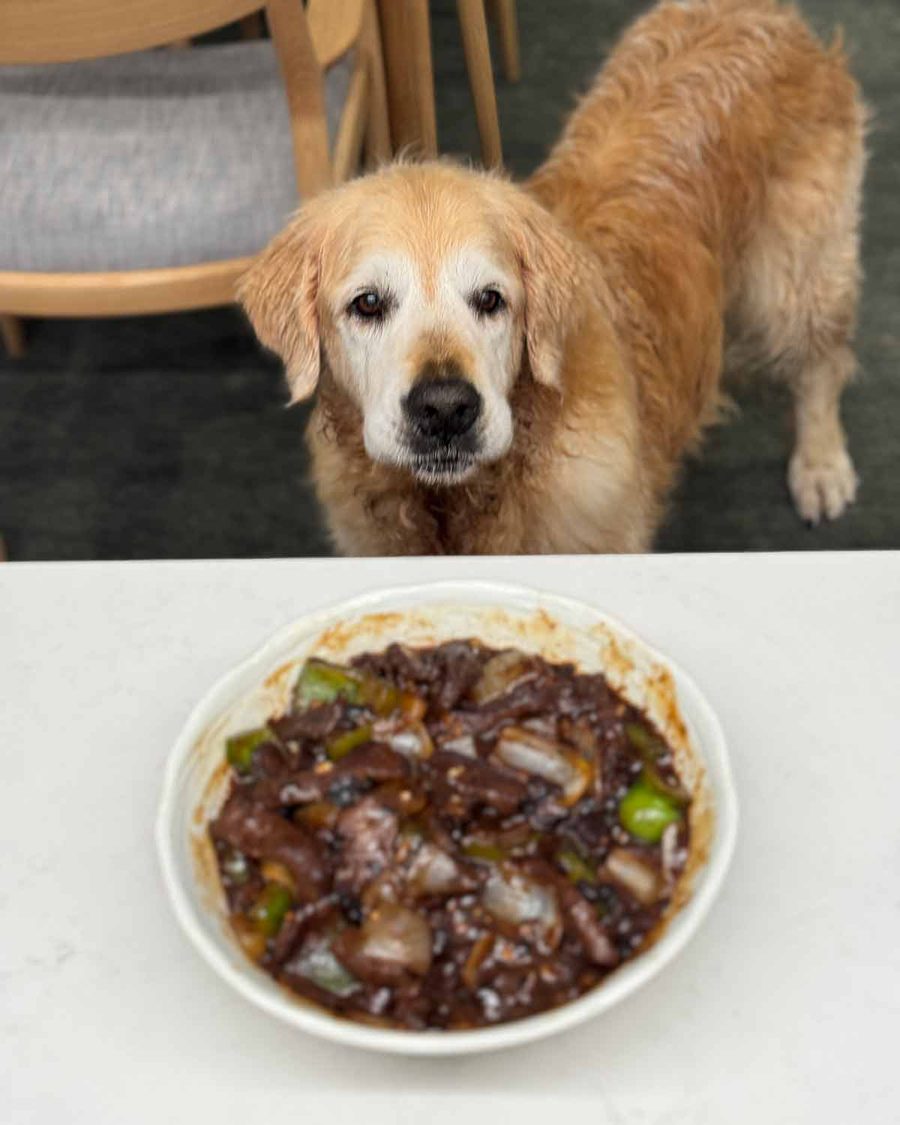
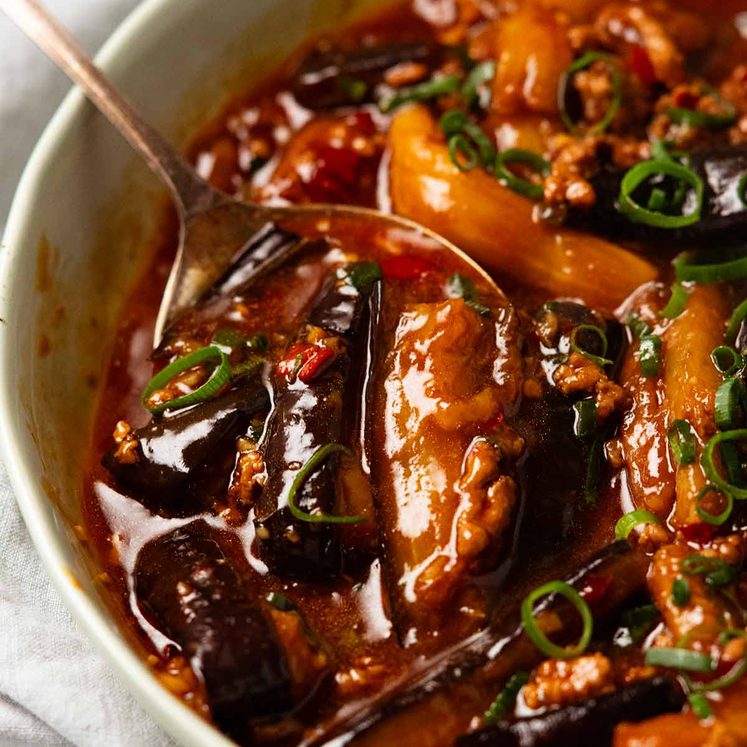
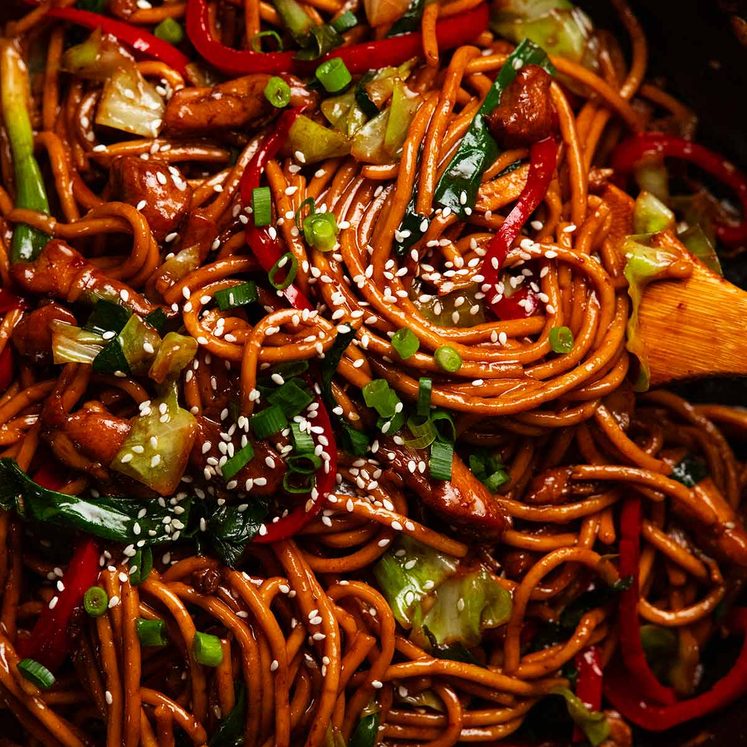
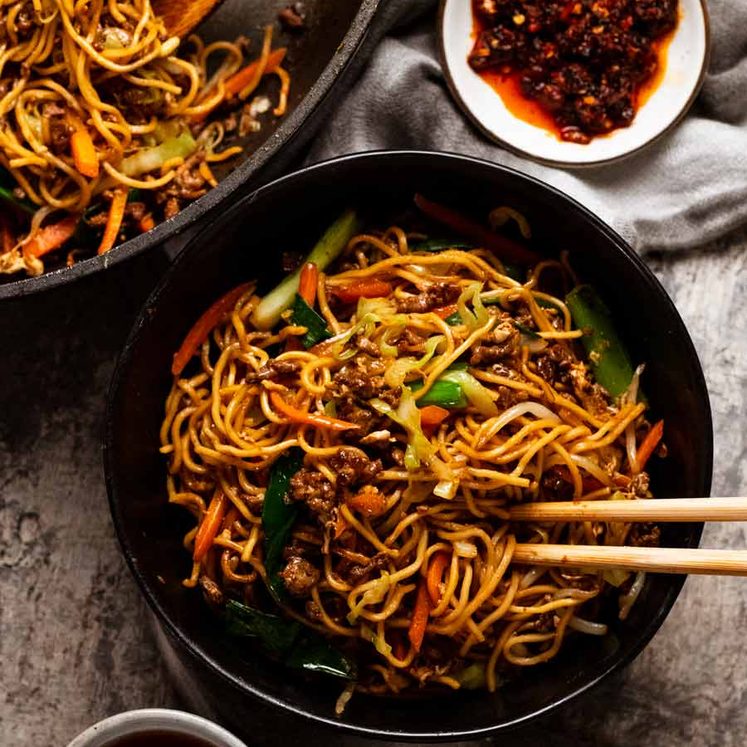
Yum. Just as good as my favourite restaurant version!
I used fermented black beans but they weren’t very salty at all, hence the dish lacked some flavour until we added some homemade chilli oil and more light soy. I will try the dish with salted fermented bl;ack beans next time
Oh yummy another keeper
Another total winner. This beef and black bean sauce is better than any restaurant version. Soooo good!
This was very good but lacked Ginger. This is the only recipe I have seen for beef or chicken in black bean sauce that does not include ginger. Add an inch of grated ginger and in my opinion it improves. Add it when you add the garlic. Also a teaspoon of crushed chillies adds a zing. Good base but needs some zing to sing
Very good. Easy to do. Not as good as crab in black bean sauce but I live in Israel now so no crab.
I am not the only one, but I omitted to leave any stars.
5 stars obviously!
This is absolutely sensational!! My partner and I scoffed the lot in one sitting! I wouldn’t bat an eye if this was served to me in a restaurant – I’d happily pay good money for this! I used chicken instead of beef and threw an extra pepper in as well. I just doubled the marinade quantity for the chicken. I must say, whilst I’m at it, I don’t use any other site for recipes now. Everything I cook from here is a total winner and I can’t thank you enough for sharing your fabulous recipes. So easy to follow and such good explanations about subs / the reasoning behind certain steps. Love the Dozer sections, too! Thank you – from two very happy bellies here in the UK! x
Can you use the drained water from the black beans in the sauce, or would this water be too salty?
I couldn’t find actual beans, only fermented black bean paste. How much of the paste should I use for proper flavor?
What can I say, except another 10/10 my hubby and I just devoured this dish, definitely a keeper Nagi, you are my go to cook, because I trust in your recipes and flavors. I’ve never made Beef and black bean! I do follow your recipe to the letter, even though, I’m not a novice! Big thanks once again!
Forgot to leave five stars in my comment. Oooh, so good.
Yup, it’s that good. Just the two of us and our eyes lit up simultaneously when we took the first bite. Leftovers two days later were just as delectable. Followed the recipe to the letter. Thank you!!
We really enjoyed this. It was great even without rice.
How do I adapt this recipe for chicken? Is the marinade required or different?
Oh wow that was epic. Universally loved by all 4 members of the family. All with differing taste preferences. Made it exactly as written plus some thinly sliced chicken thigh in addition to the rump. That will be going on regular rotation. Thanks Nagi and Hannah.
Pretty good. I tasted before serving and added a few shakes of MSG – game changer!!!!!
Thanks!
Are there any beans that are gluten free? The ones I brought contained wheat 🥲
Check Nagi’s video at 1 minute, 8 seconds as it shows the type she uses. Her’s doesn’t appear to have gluten in it as it’s only 3 ingredients.
Mine wasn’t so great. I soaked black beans for 1-1/2 hour and also then rinsed it and it was bitter. Was that my mistake?
Me too, not sure when I went wrong.
Mine was bitter, too. It’s the first one of Nagi’s recipes we didn’t like. I’m wondering whether it’s the type of beans I used…
Great, Nagi, my brother had left-overs for breakfast – hot rice and cold Black bean beef. I tried it for lunch – fantastic! All the best to you, Dozer and the team.